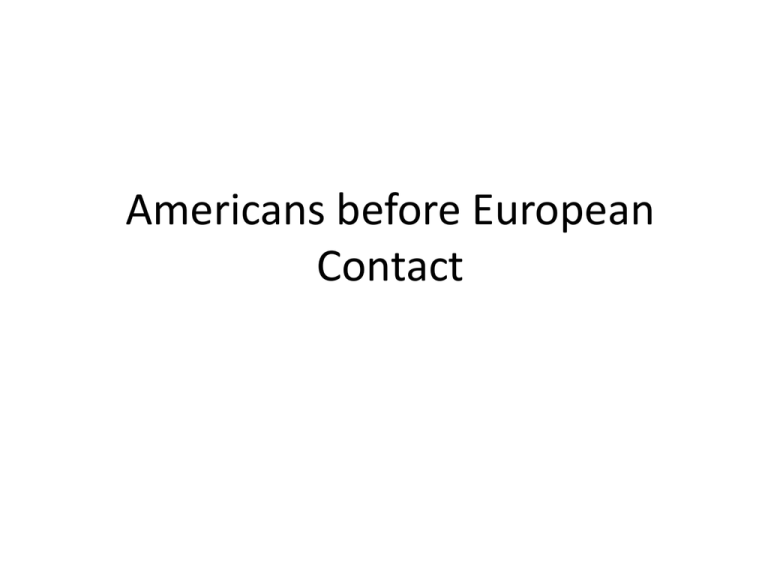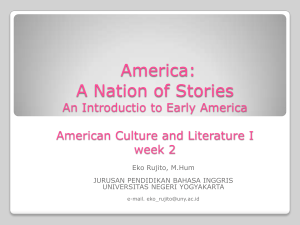
Americans before European
Contact
• “Native American”
– Refers to all indigenous peoples living in
North and South America
– “Indian” label because of a mistake
• From Spanish indio
• Columbus thought he had reached “the
Indies” (“the east” = Asia) in 1492
Pre-Columbian Native Americans
• Pre-Columbian = “before Columbus” = pre1492
• “Pre-contact” = before European contact
(extends into 20th century for some groups)
• People living in societies
–Politics, economics, conflict, change
–No more “lacking” than any other societies
(No such thing as “primitive” or “advanced”
societies)
Summary
• Pre-contact natives lived in societies not fundamentally
different from other global societies.
• They had:
– Economics, including economic inequality
– Settlements, on landscape transformed by people
– Politics, conflict, war, cooperation, diplomacy
– Innovation, experimentation, creativity
– Changes over time, sometimes rapidly
• They were not “closer to nature” or “more dependent on
the environment” than anyone else.
• They were not affected by their landscape more than
anyone else.
Insert Map
M1.1
© 2011, The McGraw-Hill
Companies, Inc. All Rights
Reserved.
North American Migrations
5
6
Pre-Columbian Native Americans
• More diverse than Europe or Asia
–Foragers and agriculturalists
–Majority practiced some farming
–Majority NOT nomads
–City-states, empires, population centers
• Central America, Central Andes
8
Native American History
• Still highly stereotyped history
• Positive and negative stereotypes together
• “Historical Myth”
– Story about past told primarily for effect,
independent of accuracy
– Not always false, but always oversimplified
– More about the storyteller than about actual events
• What people *want* to be true
– Depends on assumptions of the storytellers and
audience
– Sometimes a counter to other myths
Native American History
“Noble Savage” myth:
Natives more spiritual, more natural, “what
humans are supposed to be like”
Simple, innocent Garden of Eden before whites
Peace and harmony with each other
Traditionalist, environmentalist culture
Reality – very similar to other societies in 1492:
War, slavery, empire, invasion, genocide, ecological
destruction, social inequality, economic competition,
political conflict, shortages
Native American History
“Noble Savage” myth
Modern simplistic environmentalist version
Example: Chief Seattle’s famous speech in 1854
Most famous quotes:
Native American History
Chief Seattle’s famous speech of 1854
Actually written in 1971
By a white screenwriter from Vermont
(with little background or interest in N-A history)
Reads the 1970’s backwards into the 1850’s
Influenced by American Indian civil rights
movement, 1960’s-70’s
Influenced by modern environmentalism
More about what white social activists in
1960’s-70’s wanted to be true
An example of well-meaning “green racism”
(from a WA K-12 Social Studies module):
Native Americans respected nature.
They took care of the earth and only
used what they needed.
Native American History
“Noble Savage” myths, modern versions
“romantic holism” = a negative label for this idea:
Native Americans believed everything is sacred and
interconnected
“romantic” = idealized, heroic, Hollywood-like
“holism” = everything is connected, everything is
valuable
“conservationist culture” = N-A’s consciously decided
not to overuse resources
Pre-Contact Americans
Myth: “Lived in perfect harmony with nature”
Reality: certainly not perfect harmony
• Sometimes starvation, overhunting, depleted
topsoil
• Towns and cities
–Deforestation Mayan collapse
• Domestication of plants and animals
–Maize (“corn”) dependent on humans
–Basically, genetic engineering
–Designed to “improve upon” wild species
–NOT “just accepting nature the way it is”
Precolumbian
Native
American
biotech:
Corn
(Zea mays)
Native American societies
• Active, transformative land use
– Natives also “settlers”
• America NOT just already inhabited but already
settled
• NOT “settlers vs. natives” but “native settlers vs.
other settlers”
• “Settler” should not just refer to white people!
– Burning undergrowth, draining swamps, etc.
– America before European contact was NOT a
wilderness
• Reality:
ALL human societies are dependent on the environment.
ALL human societies are shaped by their climate,
landscape, and resources.
ALL human societies have:
economics, politics, technology, environmental
impacts, etc.
Native Americans were/are NOT more dependent on the
natural world than any other group.
Pre-Columbian Native Americans were NOT “closer to”
or “more respectful of” nature than anyone else.
Native American societies
Myths
– “Used every part of the animal”
Reality: waste piles, middens
Reality: impossible in buffalo hunts
Reality: not every single part of every single
animal
Reality: Many PNW native cultures killed
owls whenever they could, for
religious/spiritual reasons
Myth from 1960’s-70’s anti-litter campaigns
Shell midden,
Maine coast
cave midden,
desert Southwest
P
Provincial Park, Alberta, Canada
Pre-Contact Native Americans
• Reality: active, transformative land use
“Unused land” a convenient myth
Used by European Americans to rationalize
displacement:
“The savages aren’t using it anyway.”
–Ignores the reality of native settlement
–European Americans often took over prepared
farmland.
–Key to survival of Plymouth colony in 1620’s
–1830’s – U.S. applied this myth to Cherokee
plantations in Georgia!






